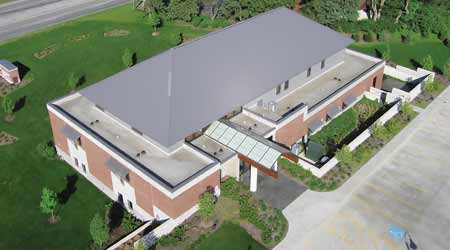 Early involvement in the planning stages of roofing projects can help managers minimize disruptions to facilities and ensure long-term roof performance.
Early involvement in the planning stages of roofing projects can help managers minimize disruptions to facilities and ensure long-term roof performance.Specifying Roofing Options Based on Facility Needs
Managers need to understand how roof technology and facility use has changed over the years in order to properly specify roofing options.
Specifying for success
One of the most common roofing mistakes managers make is to replacing a roof in kind with little or no consideration for other options. Replacing in kind assumes that the type of roof installed on the building is type best suited for the application. In fact, it is more likely that someone made the original roof selection based more on first costs than any other factor.
Replacing in kind also assumes no significant changes in the building’s use and operation during the life of the existing roof. To get a sense of these changes, consider the equipment commonly found on roofs today compared to even 20 years ago.
New operations in a building also might have resulted in the installation of rooftop exhaust systems that discharge grease or other contaminants onto the roof surface. Not all types of roof membranes respond well to the resulting foot traffic or chemical exposure.
If the roof is flat or has a low slope, an inspector should walk the roof during or shortly after rainfall to identify areas of ponding. All flat or low-slope roofs should fully drain with no water ponding 24 hours after the rain has stopped. The inspector should identify any areas of ponding on roof drawings so the replacement roof can include additional roof drains or increased slopes in those areas.
Developing specifications
New roofs represent a significant investment for facilities, yet many managers leave the selection of roof type and materials to the contractor. If managers are to get the most appropriate roof type for their facility, they must develop a scope of work or design specifications tailored to their specific application.
If the department does not have sufficient expertise to undertake this process, it is worth the additional expense to contract for this service with a qualified roofing specialist.
The specifications or scope of work for the project identify the materials, systems and application techniques to make sure all contractors are bidding on the same product. The specifications also ensure the roof to be installed is the most appropriate for that application.
The scope of work also must spell out particulars of the project that will allow contractors to properly bid it. For example, the documents should identify existing equipment located on the roof that impacts the installation. If abandoned equipment remains on the roof, the specifications should identify it along with the party responsible for its removal.
Similarly, if electrical and natural gas lines are located on the roof, the specifications should map out their location. The goal is to eliminate as many surprises as possible before the contract is signed. Surprises typically result in costly contract extras.
As functions change in a building, more HVAC condensing units are installed on a roof. In most cases, these units sit on pads that, in turn, sit on the roof surface, making the task of roof replacement more difficult. If the facility has a large number of such units located directly on the roof’s surface, managers should consider having them elevated on racks. Elevating the units might cost more, but this step will make future roof replacements easier.
Related Topics:















